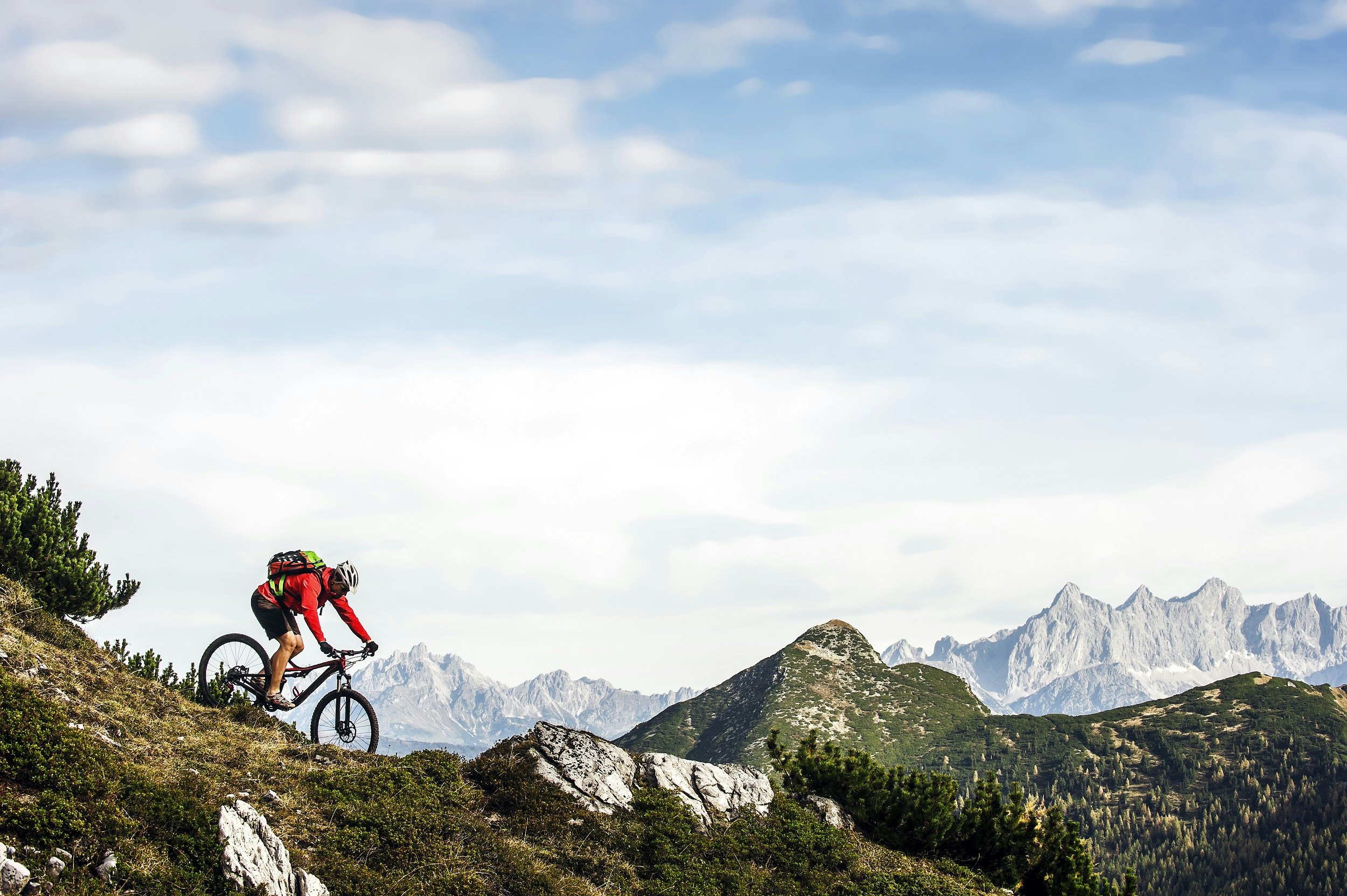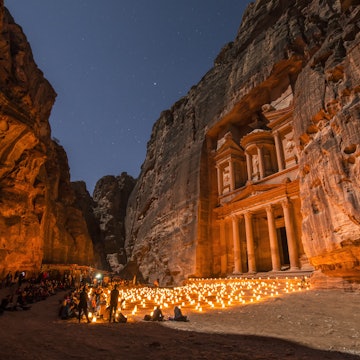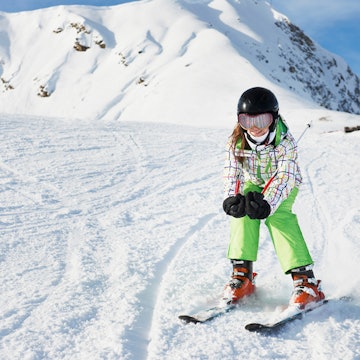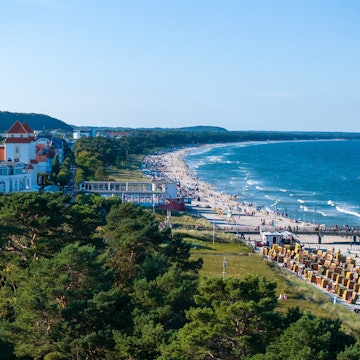
Mountaineering, kayaking, paragliding and more: finding adventure in Austria
Nov 20, 2019 • 6 min read

The rewards of hiking the Austrian Tyrol are easy to see. © mRGB / Shutterstock
For a small country, Austria packs in plenty of adventure, particularly if you love your terrain rugged and mountainous.
Austria is often overlooked as an adventure destination; its mountains are not quite as high as its Swiss and French neighbours, the Grossglockner not quite as famous as the Matterhorn or Mt Blanc. But size isn’t everything when you’ve got charm, lakes and lederhosen. And there are some pretty awe-inspiring escapades to be had. Where else can you paraglide over a city as magical as Mozart’s home town of Salzburg, take a high-adrenaline descent of a summer tobogganing run (the Rodelbahn) or ascend a Klettersteig (via ferrata) on an upturned seabed such as the Dachstein massif? You can also find world-class rapids along the Ötztaler, epic ski mountaineering in the Silvretta and follow in the dust trails of mountain biking legends at Leogang, or the Tour de France star Eddy Merckx in the Salzkammergut. If all this sounds too exhausting, well, Austria has a cure for that in the form of Kaiserschmarrn, a calorie-packed pancake that’s more effective than any performance enhancing drug. Alternatively, order yourself an Augustiner beer, first brewed by monks, and say "Prost" to that.

Hiking & trail running
Austria’s mountains have always been a popular destination for hiking holidays, and those narrow, undulating and twisting trails are equally well suited for the growing tribe of trail runners seeking challenging climbs and epic views, with a mountain hut never far from sight. The classic 120km Stubaier Höhenweg, which normally takes hikers seven to nine days, can be run in half that. Expect steep forest singletrack wending past thundering waterfalls, and soft and fast undulating trails that contour the hillsides to glacial scree and rock.
Outdoor adventures in Tyrol: where Italy meets Austria
A shorter but no less dramatic mountain excursion is to cross the Ötztal mountains west to east from the famous Gepatsch Haus to Sölden. It’s only 33km, but with two mountain ridges in between it demands deep lungs and quads of steel (and preferably a set of poles). Cold beer and glacial views don’t get better than at Braunschweiger Hut (2758m) before the final descent to Sölden.

For ultra runners who love the big community feeling of events, Austria’s answer to Mont Blanc’s UTMB is the Grossglockner Ultra Trail, a 110km one-day race around Austria’s highest mountain, which although not quite as hard, is just as epic, and way easier to enter.

Mountaineering, climbing & skiing
It’s easy to think of the Alps as a single homogenous chain of mountains, but zoom in and a myriad of chains comes to light. Even within Austria, there are several mountain groups – from the Silvretta to the Stubaital, the Kaisergebirge to the Karawanken – each with their own fiercely proud identity, geographical characteristics and signature cheese. Austria’s highest mountain, the Grossglockner (3798m) is a challenging ascent requiring crampons, rope, an ice axe and knowledge of how to use them. (The knife-edge summit ridge supplies one of those quite serious "don’t look down" moments.)
Austria's long and winding road: beauty on every bend
Most of Austria’s tallest peaks, however, are found in the Ötztal. It was here that the 5000-year-old mummified remains of Ötzi, the iceman were found. In winter the area becomes the playground of ski tourers, and skiing off the Wildspitze (3770m), the country’s second highest mountain, is high on every big-mountain skier’s tick list.
For rock climbers, the town of Innsbruck is a magnet, surrounded as it is by many of Austria’s best crags – some granite, some limestone – and home to most of its many rock stars.

Whitewater kayaking
Seeing a landscape unfold from the perspective of a river offers a uniquely immersive experience; from a kayak, it’s pure adrenaline-soaked adventure. Running rapids, crashing through walls of water and dropping narrow chutes arguably gives more fun (and terror) per 60 seconds than any other adventure sport, and Austria is home to some of the best class III to IV rivers in the Alps. The place to pay homage is the River Inn, which runs like an artery east across the country from the Swiss border through the Tyrol before turning north to Germany where it joins the River Danube. The river and its many tributaries offer epic kayaking and whitewater rafting. Take the Ötztaler – former home to the annual Sickline Extreme World Championships, it boasts both class V rapids for pros and easier runs for those who just want a morning’s madness on a raft. Most commercial runs finish up at Area 47, an extreme waterpark boasting an 80kph freefall slide, canyoning and cave abseiling – just in case you needed some more thrills.

Mountain biking
If you take your mountain biking seriously, then it’s probably best to leave the guidebooks and maps at home and head straight to Bikepark Leogang. This World Cup venue is home to nine trails of varying difficulty and brag factor, from super steep downhill and flowing singletrack to North Shore-style runs. As a rule, the idea of going uphill in Austria is an alien concept, or at least something to be endured, normally on a wide fire track with your helmet slinging off the front of your handlebars before the real business of doing downhill begins. But suckers for pain and endurance will find happiness and joy in the 210km Salzkammergut Trophy, one of the world’s toughest MTB marathons, which boasts 7119m of elevation as it takes riders around the World Heritage region of Hallstatt. Squeezed between lake and steep cliffs, Hallstatt is quite possibly Austria’s most photographed village and home to one of the oldest salt mines in the world. The route also passes near the country estate where the court of Emperor Franz Joseph kicked off WWI.

Paragliding
Every two years, the world’s top paraglider pilots descend on the city of Salzburg for the start of the Red Bull X-Alps, in which athletes hike and fly 1000km across the Alps to Monaco in as little as a week. All along its changing route are classic flying sites. The 1288m Gaisberg, which overlooks the city of Salzburg, offers some of the best city flying anywhere. Not only is it a short hike out of the city, it offers incredible views over its famous Baroque cathedrals as well as the soaring peaks of neighbouring Berchtesgaden. Not far to the southwest lies the aerial superhighway of the Pinzgau valley around Zell am See. Serviced by the Hohe Tauern mountains to the south and the Kitzbüheler Alps to the north, its reliable thermals make this a superb cross-country flying venue. Just don’t mention the dreaded "föhn", the notorious warm wind that makes flying all but impossible.
Adventure in the Alpine Foothills: Europe's best base towns for outdoor thrills
Road cycling
Cycling The Sound of Music country. Aside from being the place where the musical was filmed, Austria’s Lake District, the Salzkammergut, is cycling heaven, home to the Eddy Merckx Classic. Think lush Alpine meadows, crystal clear lakes and something else dear to the heart of every roadie – plenty of places for kaffee (coffee) and kuchen (cake).















